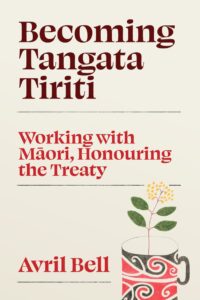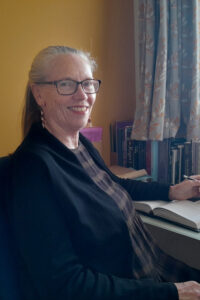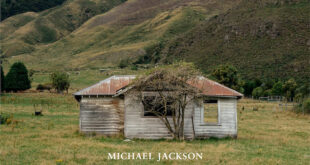Article by Avril Bell
As someone who grew up in the 1960s, I don’t recall ever hearing about the Treaty, although we did visit Waitangi to see Queen Elizabeth in 1963. The Queen was the attraction; I don’t remember learning anything about the significance of Waitangi itself. At school I never learnt anything about our national history either. I was left with the idea that nothing interesting had ever happened here. How crazy is that! Now I can’t get enough of learning about New Zealand histories! And even though I grew up in the Far North, where there is a high Māori population, it was very much a Pākehā-dominated community at the time. The Māori world had been well and truly pushed into the margins, down the dusty country roads on the edges of a Pākehā world. There was the haka at All Blacks matches, stick games and poi at school and a few words of te reo learnt in the playground. That was it.
On a national level, things really began to change in the 1970s. While Māori had been protesting against land loss and other breaches of the treaty persistently since the 1840s, the political climate of the 1970s – civils rights movements, feminism, anti-racism – meant their protests fell on more receptive ears than in earlier times. For me personally, as a trainee teacher in the 1980s, a lecture by Ranginui Walker was a real lightbulb moment. He told us about the thriving Māori economy of the 1830s-50s that literally provided a lot of the food settlements like Auckland survived on, as well as trading across the Tasman. These simple facts gave the lie to the stories I had heard growing up about Māori being ‘lazy’. I could connect the dots – the inequalities Māori experienced that I could see in my hometown were not the result of Māori ‘nature’ or character. Something had happened to them. I had no idea what at the time, but gradually I started to gain an education in New Zealand history.
Since the changes beginning in the 1970s – with the Waitangi Tribunal and treaty settlements being absolutely central to these – we have witnessed the Māori world gradually moving from the margins back towards the heart of our society. We still have a long way to go, but these shifts are to be welcomed and celebrated, not deplored and feared. My hope is that Becoming Tangata Tiriti can make a small contribution to these big longterm changes.
The questions that led to this book arose for me around twenty years ago when I noticed some iwi and hapū who had completed treaty settlements becoming increasingly prominent in their local communities. The settlements gave them some money to invest in businesses and social services, and often resulted in co-management systems being set up with organisations such as DOC to jointly manage conservation lands. I began to wonder how these ‘mainstream’ organisations like DOC, local councils and businesses of various kinds were responding to this new situation. Were they engaging constructively with the growing economic and political Māori presence? And what changes were being required of non-Māori organisations and the people working within them to make these positive relationships with Māori possible? This book is one project that emerged from my interest in these questions.
Becoming Tangata Tiriti is based on conversations with twelve non-Māori New Zealanders whose work involves them working with or for Māori in some way. They share their experiences and insights into what working well with Māori communities requires, and also talk about what they have gained personally from developing connections with the Māori world. That, I think, is one of the most interesting things for those who fear these changes in particular – these people describe win-win relationships, where their own lives have been enriched while they make their own small contribution to supporting the restoration of te ao Māori.
For some of the people in the book, the main focus of their work with Māori was with communities and organisations external to their workplace. Others worked closely with Māori colleagues, and in a couple of instances, within Māori-led teams. For some, their work straddled paid work and activism or community work, such as treaty education – most of which is directed at non-Māori, so work with non-Māori was discussed also as another kind of contribution to supporting societal change and Māori flourishing.
The people I spoke with shared interesting stories about their significant relationships with Māori friends and colleagues, the setbacks they encountered along the way, and how important and enriching those relationships have been for them. They spoke about the importance of the treaty to them as a touchstone and guide in their work, and had some really fascinating and thought-provoking things to say about the need for us non-Māori to become somewhat familiar and able to function in Māori contexts and the need also to keep out of the way and hold back at times. They talked about the positive impact their relationships with Māori had had on their own sense of who they were as New Zealanders.
The concept of tangata tiriti/people of the treaty was used by Sir Edward Taihakurei Durie in a speech he gave back in 1989 as Chair of the Waitangi Tribunal. The term asks us to think about who we are in relation to Te Tiriti/the Treaty itself and in relation to Māori as the other signatory to Te Tiriti. Becoming tangata tiriti comes with responsibilities – to get to know ourselves and our histories better, to develop constructive relationships with Māori, and to support their struggles to regain the status Captain Hobson promised they would be able to retain in 1840. While we are currently witnessing a considerable backlash against Māori and Te Tiriti from our government, people across the country continue to work as tangata tiriti in many workplaces and organizations. This book is for those people, as a window into some of the experiences and suggestions of others, in the hope it can support their own journey to becoming tangata tiriti.

Read more about Avril’s book,









Join the Discussion
Type out your comment here:
You must be logged in to post a comment.